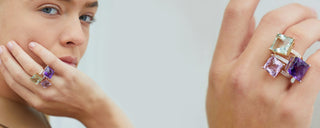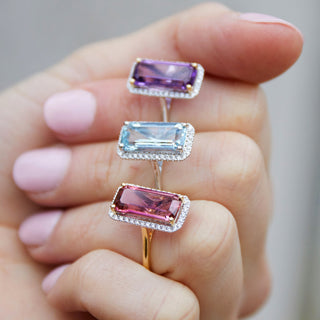
Nature's most exquisite gifts
Welcome to our comprehensive guide on precious and semi-precious gemstones, where we'll take you on a journey through nature's most exquisite gifts. Gemstones are more than just shiny rocks; they're a testament to the beauty and power of nature, each possessing a unique charm and allure that has captivated humans for centuries. In this guide, we'll explore the vivid hues, intricate patterns, and mesmerising sparkle of gemstones, and how they're essential to luxurious jewellery. From the fiery red of rubies to the deep blue of sapphires and the radiant green of emeralds, gemstones have come to symbolise elegance and sophistication, coveted treasures that are crafted over millions of years. Join us as we delve into the fascinating world of gemstone jewellery, and learn how to appreciate and choose the perfect gemstone jewellery for you.
Precious Gemstone Jewellery

RUBY JEWELLERY
Ruby is a precious gemstone known for its striking red colour and exceptional hardness. It has been used in jewellery and other decorative objects for thousands of years and is valued for its rarity and symbolic significance.

EMERALD JEWELLERY
Emerald is a precious gemstone known for its rich green colour and stunning clarity. It has been highly prized for centuries and is considered one of the most valuable gemstones in the world.

SAPPHIRE JEWELLERY
Sapphire is a precious gemstone known for its vivid blue colour, although it can also come in other colours like pink, yellow, and green. This highly sought after stone is valued for its beauty, durability, and versatility in jewellery.

Your Birthstone Gem
Gemstone birthstones are specific types of gemstones that are associated with each month of the year, with each stone having its own unique properties and symbolism.
Our birthstone jewellery guide for gemstones offers a comprehensive overview of the birthstones for each month, providing information on their history, meaning, and significance, as well as their physical properties and uses in jewellery.

Semi Precious Gemstone Jewellery
Semi-precious gemstones are a diverse group of minerals that are valued for their beauty and rarity, but are considered less valuable than precious gemstones like diamonds, rubies, emeralds and sapphires.
While they may be less expensive, semi-precious gemstones are still highly sought after for their unique colours, patterns, and textures, and have been used in jewellery and decorative objects for centuries. Examples of semi-precious gemstones include amethyst, turquoise, topaz, garnet, and many others, each with its own distinct characteristics and symbolism.
With their wide range of colours and affordability, semi-precious gemstone jewellery offer endless possibilities for jewellery design and personal expression.
Popular Semi-Precious Gemstone Jewellery

GARNET JEWELLERY
Garnet, the birthstone for January, is a popular gemstone with a rich history and deep cultural significance.

AMETHYST JEWELLERY
Amethyst is a beautiful and calming gemstone that is renowned for its deep purple colour and its association with clarity and spiritual awareness.

AQUAMARINE JEWELLERY
A gemstone compared to the colours of the ocean, with shades ranging from pale blue to deep blue-green.

PEARL JEWELLERY
Pearls are a lustrous and timeless gemstone that have been prized for their natural beauty and elegance for centuries.

PERIDOT JEWELLERY
Peridot is a vibrant and ancient gemstone that is known for its vivid green colour and its association with nature and renewal.

TOURMALINE JEWELLERY
Tourmaline is a versatile and colourful gemstone that comes in a wide range of shades and is recognised for its unique crystal formations.

TOPAZ JEWELLERY
Topaz is a sparkling and cheerful gemstone that is renowned for its warm yellow or golden hues.

TANZANITE JEWELLERY
Tanzanite is a rare and captivating gemstone prized for its striking blue-violet hue and its association with the African continent.

Cubic Zirconia - Diamond Alternative
Cubic zirconia is a synthetic gemstone that is often used as a substitute for diamond due to its high refractive index, hardness, and durability. It is made from zirconium dioxide, which is melted and then stabilised to create a crystalline structure that closely resembles diamond.
Cubic zirconias are highly versatile and can be created in a wide range of colours, shapes, and sizes. They are also much more affordable than diamonds, making them a popular choice for both fashion and fine jewellery.
While they may not have the same inherent value or rarity as natural gemstones, cubic zirconias offer an accessible and beautiful alternative for those looking to add a touch of sparkle to their jewellery collection.
Learn more about white and colourless gemstone jewellery in our blog: Pearls and Diamonds: Stars amongst White Gemstone Jewellery
Gemstone Jewellery by Colour

RED GEMSTONE JEWELLERY
Red gemstones are a fiery and passionate group of stones that come in a variety of shades and are often chosen for their bold and intense colours.

YELLOW GEMSTONE JEWELLERY
Yellow gemstones are a bright and sunny group of stones that come in a variety of shades and are ecognised for their cheerful and uplifting energy.

BLUE GEMSTONE JEWELLERY
Blue gemstones are a cool and calming group of stones that come in a variety of shades and are prized for their soothing and peaceful qualities.

GREEN GEMSTONE JEWELLERY
Green gemstones are a fresh and vibrant group of stones that come in a range of tones and are selected for their natural beauty and association with growth and renewal.

Gemstone Certification & Grading
Gemstone certification and grading in the United Kingdom is typically done by independent gemological laboratories that specialise in evaluating the quality and authenticity of gemstones. One of the most well-known and respected organisations is the Gemological Institute of America (GIA), which has a branch in London. The GIA uses a rigorous grading system that assesses the colour, clarity, cut, and carat weight of a gemstone. Other organisations that offer gemstone certification in the UK include the International Gemological Institute (IGI), the Gemmological Association of Great Britain (Gem-A), and the National Association of Jewellers (NAJ).
These organisations provide certificates that serve as a guarantee of a gemstone's authenticity and quality, and can be particularly important for high-value gemstones. When purchasing gemstones from Sonny's, we will always provide a certificate from a reputable gemological laboratory to ensure quality and traceability.


